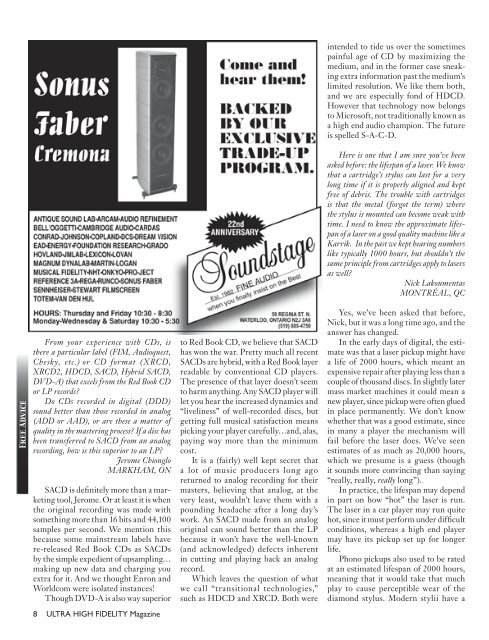UHF No 70 (Net).indd - Ultra High Fidelity Magazine
UHF No 70 (Net).indd - Ultra High Fidelity Magazine
UHF No 70 (Net).indd - Ultra High Fidelity Magazine
Create successful ePaper yourself
Turn your PDF publications into a flip-book with our unique Google optimized e-Paper software.
Free Advice<br />
From your experience with CDs, is<br />
there a particular label (FIM, Audioquest,<br />
Chesky, etc.) or CD format ( XRCD,<br />
XRCD2, HDCD, SACD, Hybrid SACD,<br />
DVD-A) that excels from the Red Book CD<br />
or LP records?<br />
Do CDs recorded in digital (DDD)<br />
sound better than those recorded in analog<br />
(ADD or AAD), or are these a matter of<br />
quality in the mastering process? If a disc has<br />
been transferred to SACD from an analog<br />
recording, how is this superior to an LP?<br />
Jerome Chionglo<br />
MARKHAM, ON<br />
SACD is defi nitely more than a marketing<br />
tool, Jerome. Or at least it is when<br />
the original recording was made with<br />
something more than 16 bits and 44,100<br />
samples per second. We mention this<br />
because some mainstream labels have<br />
re-released Red Book CDs as SACDs<br />
by the simple expedient of upsampling…<br />
making up new data and charging you<br />
extra for it. And we thought Enron and<br />
Worldcom were isolated instances!<br />
Though DVD-A is also way superior<br />
8 ULTRA HIGH FIDELITY <strong>Magazine</strong><br />
to Red Book CD, we believe that SACD<br />
has won the war. Pretty much all recent<br />
SACDs are hybrid, with a Red Book layer<br />
readable by conventional CD players.<br />
The presence of that layer doesn’t seem<br />
to harm anything. Any SACD player will<br />
let you hear the increased dynamics and<br />
“liveliness” of well-recorded discs, but<br />
getting full musical satisfaction means<br />
picking your player carefully…and, alas,<br />
paying way more than the minimum<br />
cost.<br />
It is a (fairly) well kept secret that<br />
a lot of music producers long ago<br />
returned to analog recording for their<br />
masters, believing that analog, at the<br />
very least, wouldn’t leave them with a<br />
pounding headache after a long day’s<br />
work. An SACD made from an analog<br />
original can sound better than the LP<br />
because it won’t have the well-known<br />
(and acknowledged) defects inherent<br />
in cutting and playing back an analog<br />
record.<br />
Which leaves the question of what<br />
we call “transitional technologies,”<br />
such as HDCD and XRCD. Both were<br />
intended to tide us over the sometimes<br />
painful age of CD by maximizing the<br />
medium, and in the former case sneaking<br />
extra information past the medium’s<br />
limited resolution. We like them both,<br />
and we are especially fond of HDCD.<br />
However that technology now belongs<br />
to Microsoft, not traditionally known as<br />
a high end audio champion. The future<br />
is spelled S-A-C-D.<br />
Here is one that I am sure you’ve been<br />
asked before: the lifespan of a laser. We know<br />
that a cartridge’s stylus can last for a very<br />
long time if it is properly aligned and kept<br />
free of debris. The trouble with cartridges<br />
is that the metal (forgot the term) where<br />
the stylus is mounted can become weak with<br />
time. I need to know the approximate lifespan<br />
of a laser on a good quality machine like a<br />
Karrik. In the past we kept hearing numbers<br />
like typically 1000 hours, but shouldn’t the<br />
same principle from cartridges apply to lasers<br />
as well?<br />
Nick Lakoumentas<br />
MONTRÉAL, QC<br />
Yes, we’ve been asked that before,<br />
Nick, but it was a long time ago, and the<br />
answer has changed.<br />
In the early days of digital, the estimate<br />
was that a laser pickup might have<br />
a life of 2000 hours, which meant an<br />
expensive repair after playing less than a<br />
couple of thousand discs. In slightly later<br />
mass market machines it could mean a<br />
new player, since pickup were often glued<br />
in place permanently. We don’t know<br />
whether that was a good estimate, since<br />
in many a player the mechanism will<br />
fail before the laser does. We’ve seen<br />
estimates of as much as 20,000 hours,<br />
which we presume is a guess (though<br />
it sounds more convincing than saying<br />
“really, really, really long”).<br />
In practice, the lifespan may depend<br />
in part on how “hot” the laser is run.<br />
The laser in a car player may run quite<br />
hot, since it must perform under diffi cult<br />
conditions, whereas a high end player<br />
may have its pickup set up for longer<br />
life.<br />
Phono pickups also used to be rated<br />
at an estimated lifespan of 2000 hours,<br />
meaning that it would take that much<br />
play to cause perceptible wear of the<br />
diamond stylus. Modern stylii have a

















